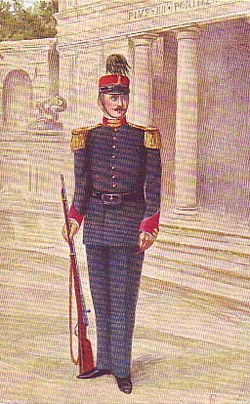History
After 1870 and the unification of Italy, the corps was confined to Vatican City where they performed ceremonial functions as a guard of honor. The Palatine Guard were usually seen either when the Pope was in Saint Peter's Square, or when a head of state or other important visitors were received by the Pope. Members of the corps were part-time volunteers, who were not paid for their service, though they received an allowance for replacement or repair of their uniforms. The unit lacked modern weapons and the guardsmen received little training beyond drill in marching and presenting arms. [2] The corps was also the only one in the service of the Vatican to have a full military band.
The Second World War was a high point in the history of the Palatine Guard. In September 1943, when German troops occupied Rome in response to Italy's conclusion of an armistice with the Allies, the Guard was given the responsibility of protecting Vatican City, various Vatican properties in Rome, and the Pope's summer villa at Castel Gandolfo. The guardsmen (mainly Roman shop keepers and office clerks) whose service had previously been limited to standing in ranks and presenting arms at ceremonial occasions, now found themselves patrolling the walls, gardens and courtyards of Vatican City and standing guard at the entrances to papal buildings around the Eternal City. On more than one occasion this service resulted in violent confrontations with Italian Fascist police units working with the German authorities to arrest political refugees who were hiding in buildings protected by the Vatican. [3] At the outbreak of the Second World War in September 1939 the Palatine Guard mustered some 500 men, but the German occupation required the recruitment of additional personnel. By the liberation of Rome in June 1944 the corps had grown to 2,000 men, but at the end of the war the majority of these men left the Pope's service and the unit returned to its pre-war force level.
This page is based on this
Wikipedia article Text is available under the
CC BY-SA 4.0 license; additional terms may apply.
Images, videos and audio are available under their respective licenses.
